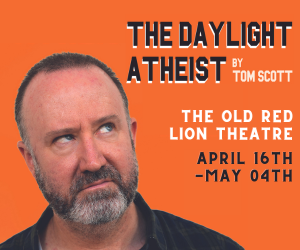Advertising is an important part of selling your show, but for those more familiar with blocking a scene or doing a cue to cue, being the one tasked with sorting out the ads for your run can throw you into an unfamiliar world of jargon and technical requirements. Here are some tips to help you understand how online and print ads work, and how to get the best out of your marketing budget.
Advertising Design
Call To Action
Your ad banner artwork needs to give the viewer a reason to click. In marketing parlance, it's called the 'Call To Action'. That can be a simple as text saying 'Book Now', or you can get clever and say something like 'Click for an exclusive video preview' (assuming you have an exclusive video preview, of course). The point is you want to create a sense of urgency or reward for clicking your banner. This is not like a static poster hanging on the wall; you want the viewer to interact so you need to tell them what to do. Advertising banners on Broadway Baby can be in PNG, JPG or GIF format. Smart advertisers use GIF because it offers something the other two formats can't - animation. Animated GIF files can be thought of as mini slide shows which display frames in a loop. That means you can put an awful lot more information on an Animated GIF, plus the animation itself is more eye catching than a static file.
GIF animation is a bit of a specialist skill though, so you'll need to have a graphic design in your team that knows the format. File sizes need to be kept under 150k, so you need to be smart with which parts of the image is animated.
Advertising Jargon
Impressions
An 'impression' is a single time your ad is displayed. Sometimes also called a 'view', when you buy a number of impressions, that's the number of times your banner will be displayed on the site.
Click-Through
A click-through (or click-thru for our American visitors) is the action of a visitor clicking your banner and being taken to another website or landing page. The click-through rate is the number of times your banner is clicked divided by the number of impressions shown. So if you've displayed 100 banners and it has been clicked once, that's a click-through rate of 1%. The global click-through rate of banners is actually pretty low at about 0.1% (the average on Broadway Baby is about 0.3% since focused subject sites like this one with focus ads tend to produce better click throughs), but you should consider banner advertising to be part of your branding exercise – which is why it's very important that your poster/flyer image matches your advertising.
Tenancy
A tenancy is a advert booked for a specific period of time - ads booked on Broadway Baby use this method to take the guesswork out of booking.
CPC
CPC stands for Cost Per Click - this is a popular method on Google where you pay every time someone clicks on your advert regardless of how often it is viewed. CPC can have benefits if you have a popular advert with a low cost keyword, but it is the most difficult advertising model for the newbie to understand as there are so many variables to consider.
CPM
CPM stands for Cost Per Thousand (or Cost Per Mille) - in this model you pay for the number of impressions you advert receives. Broadway Baby used to use this model, but our advertisers found it difficult to judge just how many impressions they needed to buy. Hence why we switched to tenancy.
File Formats
Ads on Broadway Baby can be in JPG, PNG or GIF format. These are simply the graphic format the image is saved in. Each has its own advantages depending on your actual image. JPG and PNG are always static and offer better quality if your image is very photographic. GIF can be static or animated, allowing you to have several frames within the same space so you can show the title, venue, dates and quotes without making the text so small it's unreadable. You do have to ensure your ad filesize is under 100k (a max limit imposed so the visitor doesn't click away from the page before your banner has had a chance to load). Broadway Baby doesn't support Adobe Flash files since so much of our traffic is increasingly coming from mobile phones and tablets that don't support it.
How to Advertise with Broadway Baby
For online advertising - do it online! Simply click here to visit our online banner booking page.











